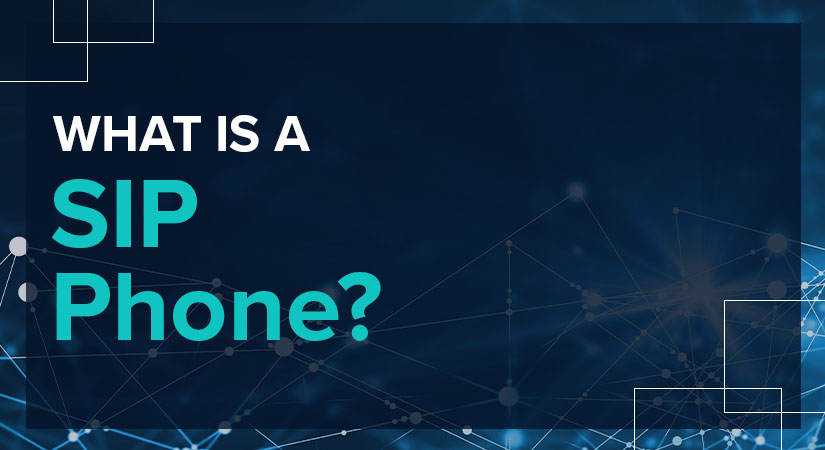What is a SIP phone, how does it work, and why are companies investing in SIP technology?
SIP, or “Session Initiation Protocol,” is one of the core technologies in the current communication landscape. It’s at the heart of the rapidly growing “SIP Trunking” landscape, set to reach a market value of $43.47 billion by 2031. SIP also plays a significant role in the evolving “UCaaS” or Unified Communications as a Service space.
SIP phones enable business leaders to move beyond the age of old-fashioned communications systems reliant on copper wires and switches. Organizations can connect employees, customers, and stakeholders using an IP-based (internet) network with SIP solutions.
Let’s explore what SIP phones are, how they work, and why they’re so beneficial.
What is a SIP Phone? Defining SIP Technology
We first need to understand “SIP” or Session Initiation Protocol to define SIP phones.
SIP is a communication protocol for managing multimedia communications over an internet connection. SIP is one of the core recognized standards in the communication landscape used to facilitate VoIP (Voice over Internet Protocol).
However, this technology can also enable “Unified Communications” by transmitting various kinds of data outside of voice, like instant messaging, email, video, and more. The versatility of the SIP environment is one of the primary reasons it has become so valuable to modern brands.
A SIP phone is a device that leverages the SIP network protocol for communications.
From a technical perspective, SIP devices operate using relatively straightforward commands. When a SIP phone makes a call, the device notifies a server or business VoIP service.
The server then initiates a connection with another extension or patches the call to the PSTN environment. During the call, the SIP server maintains the quality of the call.
Why are SIP Phones Important?
Unlike traditional phones, SIP phones don’t rely on access to the “PSTN” or Public Switched Telephone Network. Instead, they enable calls and content sharing entirely through an internet connection. This transition to internet-based calls is becoming increasingly important for many companies in various parts of the world as governments move away from PSTN and ISDN systems.
The UK will officially shut down the ISDN and PSTN solutions in 2025. This will end reliance on traditional copper wires and switches for transmitting and receiving voice data. For decades, the PSTN environment has allowed companies to manage calls over “traditional telephony lines.”
However, ISDN and PSTN technologies are no longer fit for purpose in an environment where large amounts of multimedia need to be transmitted at incredible speeds.
Tools like SIP allow companies to leverage a host of benefits, including:
- Scalability: Companies can rapidly scale their SIP connections according to their specific needs, purchasing new lines and seats on demand. Upgrading a SIP environment takes minutes, and there’s no need for complex additional configuration.
- Cost savings: SIP solutions use the internet to transmit data, so companies don’t have to budget for a host of different calling rates when communicating with people worldwide.
- Enhanced maintenance: SIP solutions often come with built-in tools businesses can use to monitor call quality and enhance the communication system easily. SIP trunking providers can even re-route services in the case of an outage and provide redundancy.
- Enhanced sound quality: Removing network switches and copper lines from the equation can improve sound quality and a more professional image for brands. SIP phones usually suffer from fewer instances of lag and latency too.
- Continuity: SIP phones can allow companies to provide communication technology to all their team members, including remote and hybrid staff, without compromising performance. Vendors can also route calls from a phone to a mobile extension.
SIP Phone Features and Functionality
SIP phones typically fall into two categories: hard phones and softphones. A hard phone looks similar to a standard desktop phone and behaves much similarly.
However, instead of connecting to copper cables and the PTSN environment, a SIP phone links to the internet using an ethernet cable. Hard SIP phones come in various sizes and forms to suit specific business needs. Basic SIP phones can be simple, budget-friendly tools with straightforward dial pads, call tones, and routing services.
More advanced SIP phones can include touch screens, browsable directories, integrations with leading UCaaS tools, and more. Some of the top SIP phones on the market may even have a full-color display. Others will have Wi-Fi and Bluetooth compatibility, and a built-in camera for conferencing.
Softphones in the SIP landscape are applications that provide users with phone service functionality via software installed onto a smartphone, laptop, or desktop. Once a VoIP app has been installed, users can use a headset, microphone, or their existing smartphone functions to manage calls.
The type of SIP phone, a company chooses for its communication will influence its feature sets.
Most SIP phones will include access to the following:
- Mobile and desktop app integrations
- Hold options with optional music
- Routing functionality
- Conference calling for multiple users
- Video meetings
- Custom caller IDs
- Call recording
- Shared local call appearance
Some solutions may also feature intelligent voice assistants, call transcription capabilities delivered through screens, HD noise cancellation, audio enhancements, and more.
Switching to a SIP Phone Environment
For some time now, SIP phones have offered business leaders an opportunity to migrate from the old-fashioned communication ecosystem into the future of internet connectivity. As more countries and locations phase out the costly and static ISDN and PTSN environments, tools like SIP phones will grow increasingly essential to all companies.
Any organization hoping to leverage the power of VoIP or devise a UCaaS strategy for multi-channel communications will need to consider installing the technology. Fortunately, virtually every telecommunications vendor now offers business leaders a range of ways to leverage SIP and SIP trunking with minimal effort.







